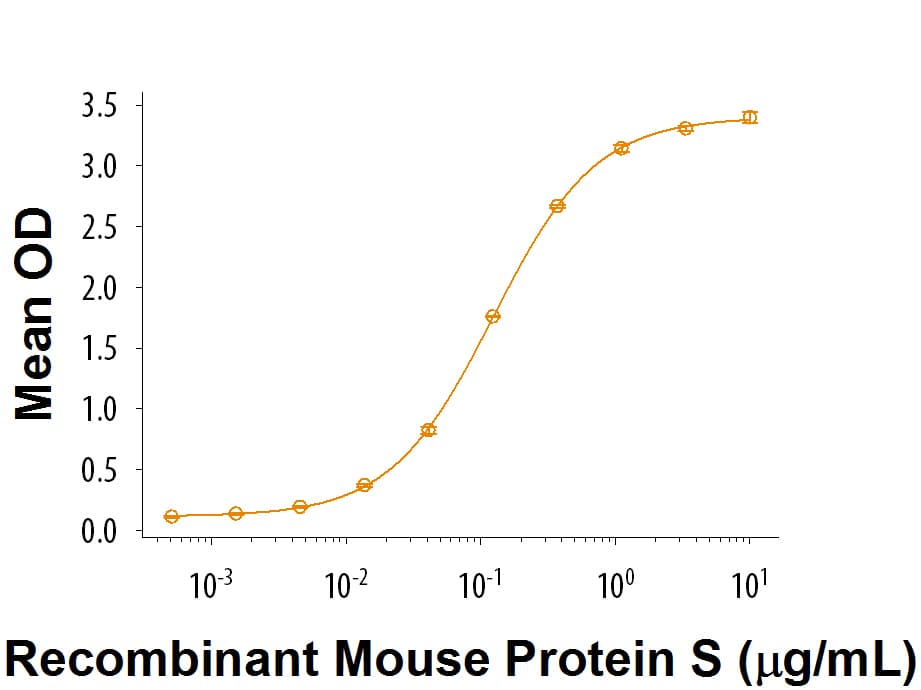 全部商品分类
全部商品分类

 下载产品说明书
下载产品说明书 下载SDS
下载SDS 用小程序,查商品更便捷
用小程序,查商品更便捷


 收藏
收藏
 对比
对比 咨询
咨询Scientific Data
 View Larger
View LargerWhen Recombinant Mouse Dtk Fc Chimera (Catalog # 759-DT) is immobilized at 1 µg/mL, 100 µL/well, Recombinant Mouse Protein S/PROS1 (Catalog # 9740-PS) binds with an ED50 of 0.04-0.24 µg/mL.
Carrier Free
CF stands for Carrier Free (CF). We typically add Bovine Serum Albumin (BSA) as a carrier protein to our recombinant proteins. Adding a carrier protein enhances protein stability, increases shelf-life, and allows the recombinant protein to be stored at a more dilute concentration. The carrier free version does not contain BSA.
In general, we advise purchasing the recombinant protein with BSA for use in cell or tissue culture, or as an ELISA standard. In contrast, the carrier free protein is recommended for applications, in which the presence of BSA could interfere.
9740-PS
| Formulation | Lyophilized from a 0.2 μm filtered solution in HEPES, NaCl, and CaCl2. |
| Reconstitution | Reconstitute at 500 μg/mL in water. |
| Shipping | The product is shipped with polar packs. Upon receipt, store it immediately at the temperature recommended below. |
| Stability & Storage: | Use a manual defrost freezer and avoid repeated freeze-thaw cycles.
|
Recombinant Mouse Protein S/PROS1, CF Summary
Product Specifications
Ala42-Arg669, with a C-terminal 10-His tag
Analysis

Background: Protein S/PROS1
Anticoagulant Protein S (PROS1) is a 71 kDa plasma vitamin K-dependent glycoprotein characterized by the presence of the post-translational modification of specific glutamic acid residues to gamma-carboxyglutamic acid (Gla) in the N-terminal region. In addition to the N-terminal Gla domain, mature PROS1 contains a thrombin‑sensitive thumb loop, four tandem EGF-like domains and a C-terminal sex hormone-binding globulin (SHBG) domain composed of two Laminin G (LG) domains (1). Mouse PROS1 shares 80% aa sequence identity with human PROS1. Hundreds of mutations in humans have been reported throughout all the domains of the protein, typically resulting in PROS1 deficiency and an increase in the risk of thrombophilia (2, 3). PROS1 is expressed in many cell types supporting its reported involvement in multiple biological processes that include coagulation, apoptosis, cancer development and progression, and the innate immune response (4-9). PROS1 exists in plasma both in complex with C4b-binding protein (C4BP) (60%) and in a free form (40%). Both forms of PROS1 have anticoagulant activity either directly through inhibition of Factor X systems and prothrombinase while in complex with C4BP (5, 10) or in its well-established role as a cofactor of activated protein C (APC) inactivation of procoagulants FVa and FVIIIa (4). The free form of PROS-1 is also a ligand for a subfamily of receptor tyrosine kinases known as TAMs, which is composed of TYRO3, AXL, and MERTK (11). PROS-1 binds these tyrosine kinase receptors through its LG domains to activate downstream signaling pathways involved in tumor development and progression (7, 8, 11, 12).
- Dahlback, B. et al. (1986) Proc. Natl. Acad. Sci. 83:4199.
- Garcia de Frutos, P. et al. (2007) J. Thromb. Haemost. 98:543.
- Heeb, M. J. (2008) Expert Rev. Hematol. 1:9.
- Walker, F.J. (1984 Sem. Thromb. Hemosta. 10:131.
- Heeb, M. J. et al. (2004) J. Thromb. Haemost. 2:1766.
- Che Mat, M. F. (2016) Int. J. Oncol. 49:2359.
- Abboud-Jarrous, G. et al. (2017) Oncotarget. 8:13986.
- Qin, J. et al. (2016) Sci. Rep. 6:26662.
- Davra, V. et al. (2016) Cancers (Basel). 8:E107.
- Hackeng, T. M. et al. (1994) J. Biol. Chem. 269:21051.
- Tsou, W.I. et al. (2014) J. Biol. Chem. 289:25750.
- Linger, R.M.A. et al. (2008) Adv. Cancer Res. 100:35.





